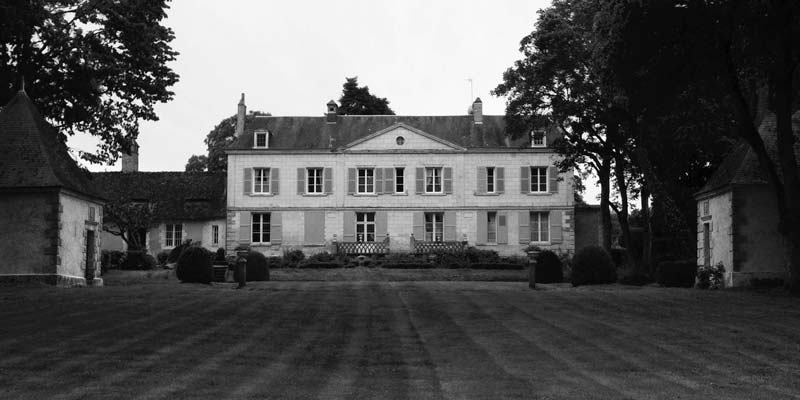the Pintray site has almost always been occupied by men. Already in the time of the Gallo-Romans, there was a settlement. But let’s travel through time to a time when written documents tell us.
A castle…
Pintray is a seigniorial place which is mentioned as early as 1467. This stronghold then belonged to Pierre Pelé, merchant-draper, and came under the lordship of Roche Charge. There is a description of Pintray in 1547, which then consists of ‘houses, barn, cattle roofs, dovecote, warren, vineyard, arable and non-ploughable land, coppiced woods, bushes, thickets’. The stately house belonged in 1578 to François Pain and his wife. They left their coat of arms on the pediment of the chapel and one of the two pavilions that we admire today.
But it was Olphan du Gast, Master of Waters and Forests, Captain of the Great Hunts, who built the castle around 1612. Pintray thus became under Louis XIII a meeting place in the Amboise forest.
From this period, the ground floor remains, with alternating bosses. The term “bossages” refers to the stone projections left on the facade of a building as ornament. The first floor did not exist. The chapel also dates from this period, it consists of a square pavilion, with bosses at the corners and a small octagonal bell tower.
The Gast family will keep Pintray for 150 years.
In 1744, the castle passed to Claude-François de la Noue. His widow, in turn, sold it, in 1768, to the Duke of Choiseul, peer of France, prime minister of Louis XV, who owned the neighboring castle of Chanteloup. There, this man of the Enlightenment lived surrounded by his court in magnificence and festivities. Before ceding her property, the widow of La Noue had the chapel bell transported to the chapel of Saint-Denis d’Amboise.
Choiseul was not to keep the land of Pintray for very long, he sold it to Luc Alen, brigadier of the King’s armies, Major of the Lally-Tollendal regiment, alongside whom he led the Indian War.
During the Revolution, the widow Alen, “noted as an aristocrat in public opinion,” was imprisoned in Amboise. Declared national property, the lands and the castle of Pintray were inventoried on the fifth Floréal of Year II of the Republic:
“We entered a large master building located at the place of Pintray composed of a kitchen, office, discharge room next door,
a living room, a fruit cabinet, a bedroom, servant’s cabinet next door, small entrance corridor and opposite the step to go up to the attic and attic bedroom, a large room, in which there is a door to the south window to pass to the garden below, another small corridor opposite another staircase to go up, similarly in the attic and attic bedroom, another large bedroom with fireplace, cabinet next door, attic and two attic rooms on top covered with slate, a garden containing approximately twenty-five chains enclosed by walls decorated with fruit trees, a communication door to go to the vineyard enclosure to the south, a small pavilion covered with slate, in the corner of the wall of the said garden, to the south and to the north, at the other corner of the latrines, an entrance door to the north closed with a wooden gate with a space of land opposite the said building currently smoked with hemp, this one containing half a quarter, a pavilion to the east with an adjoining lean-to, and to the west a former chapel, all the said buildings covered partly in tiles and the majority in slate.”
The whole thing is estimated at 2500 pounds, not counting outbuildings or land. The outbuildings include several cellars and a large barn in which there is a large wheel press with its utensils and vats. One of them has a capacity of 25 pieces (approximately 5575 liters). This confirms the wine-growing vocation of the estate.
Pintray still did not have a first floor. This was built in 1829, which gave the castle its current appearance.
…A land of vines
Pintray is also a very old place for vines. It was the monks of Saint-Martin de Tours who spread this culture around Lussault. François 1st, then Henri IV tasted wine from the surrounding hills when they came to the Château de la Bourdaisière.
As shown in an 18th century plan, Pintray was planted partly in arable land (represented by the letter T), partly in vines (letter V). The nearby Loire allowed the export of local wines to Nantes, destined for Nordic, English and Dutch countries, since the end of the 16th century. From the opening of the Orléans Canal in 1692, another part of the harvest left for Paris, a major consumer.
Since 1937, the lands of Pintray have been part of the appellation area, AOC Montlouis-sur-Loire. The finesse and softness constitute the character of this white wine, so appreciated by all. Its particular aromas, fruity and mineral, make it an exceptional product.
The new owners of Pintray, since 1990, Maryvonne and Marius Rault continue the tradition.
